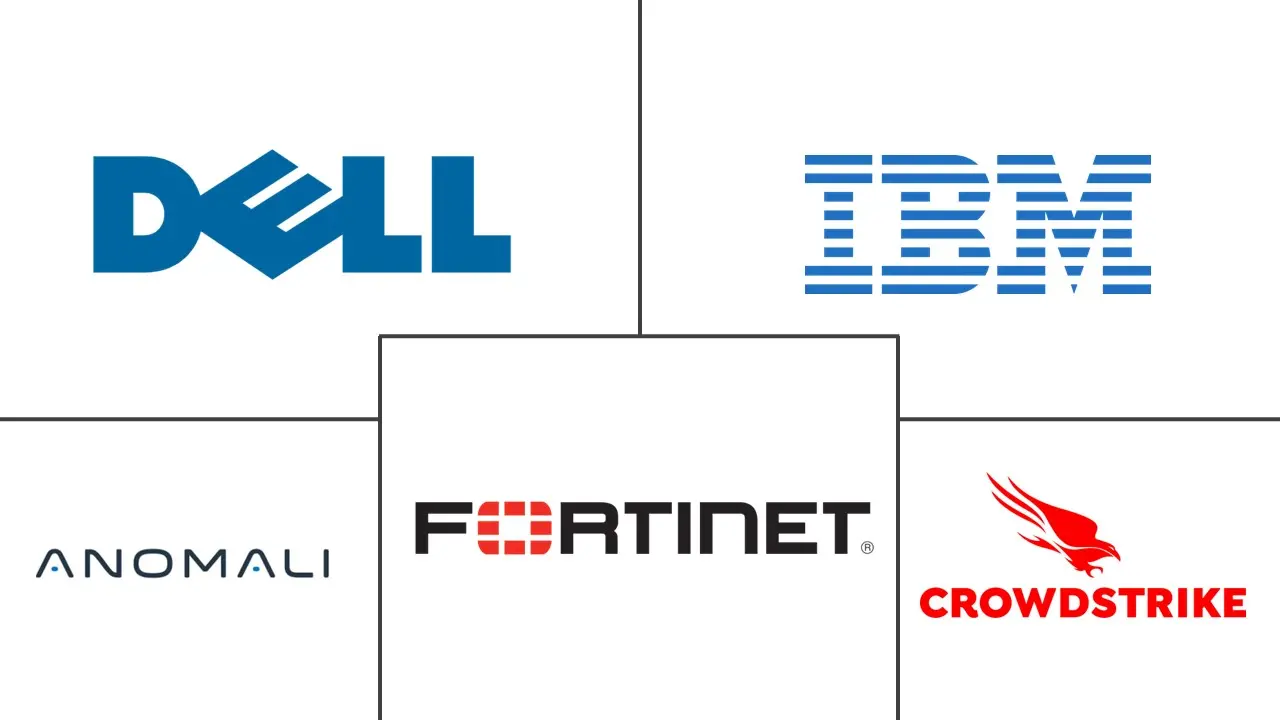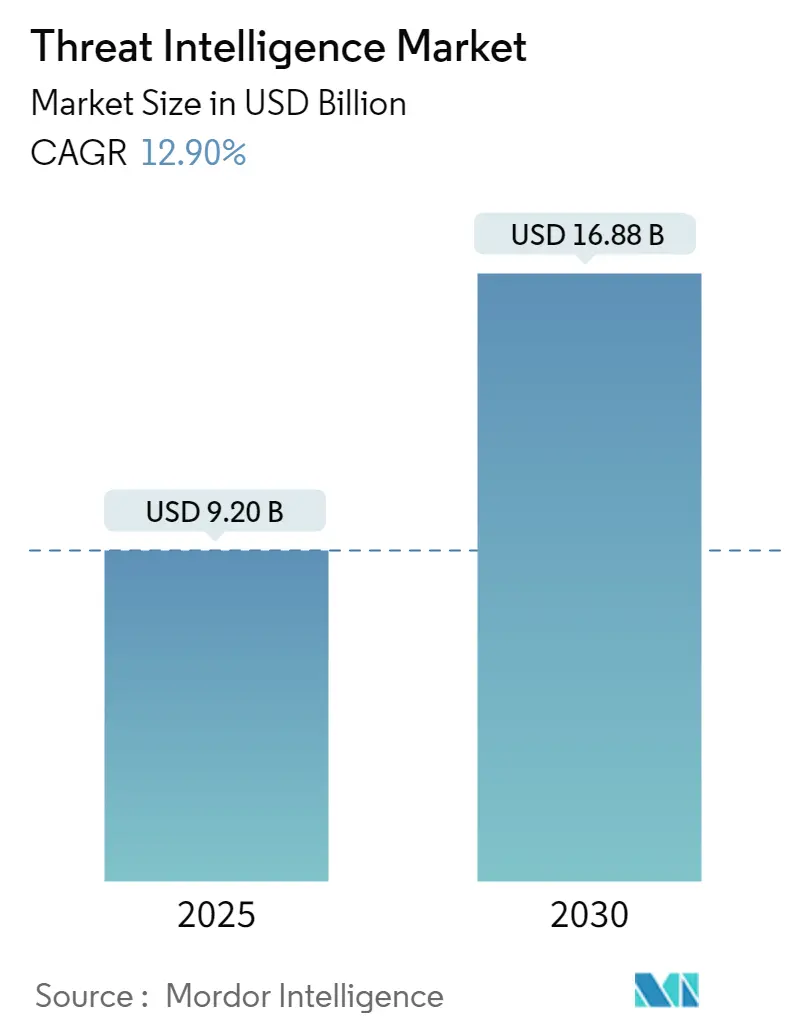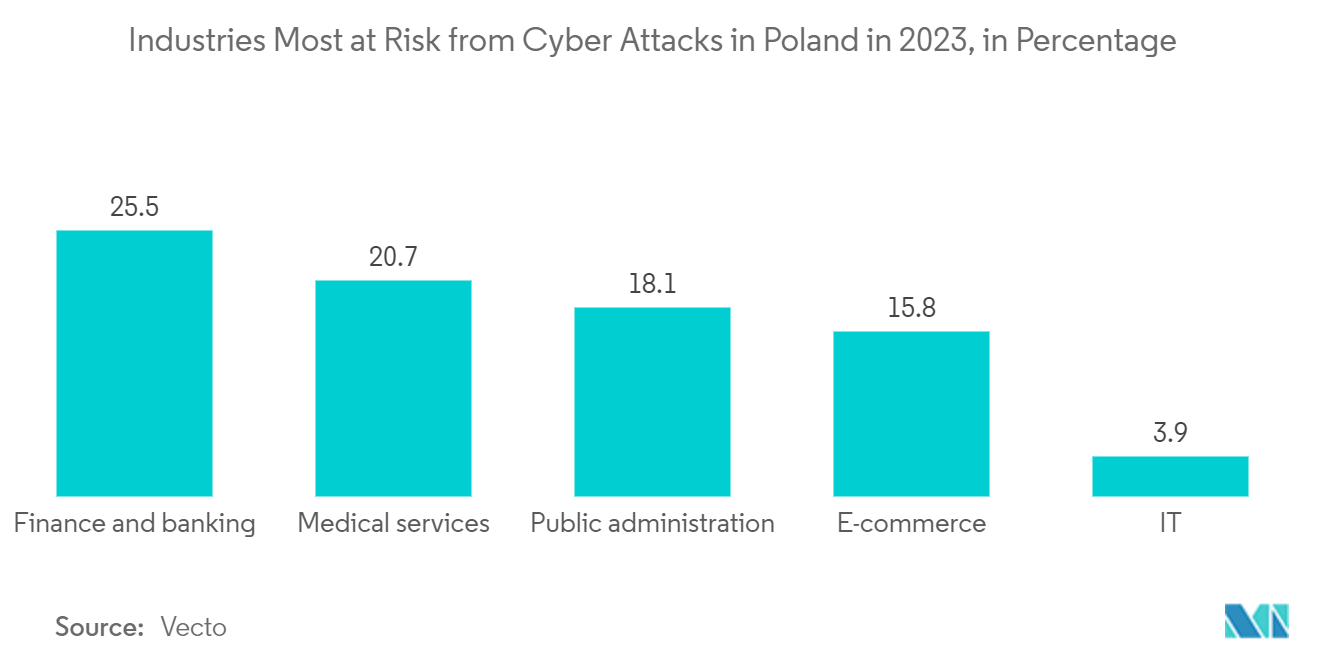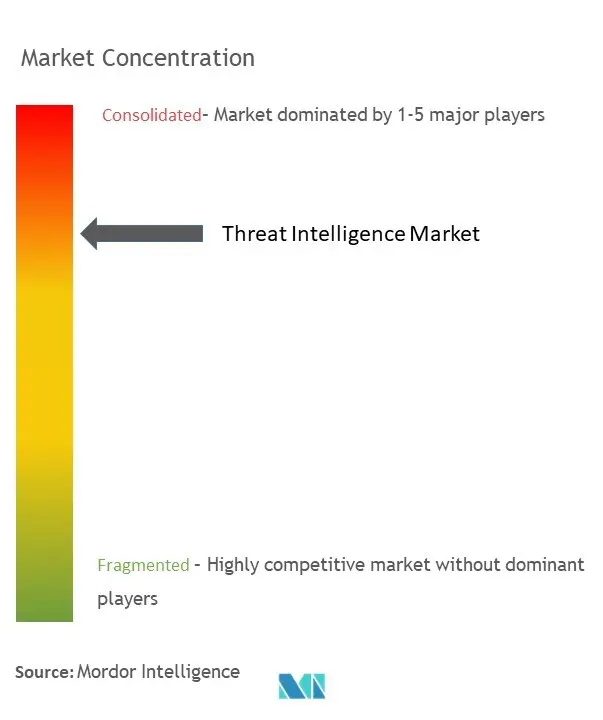Threat Intelligence Market Analysis
The Threat Intelligence Market size is estimated at USD 9.20 billion in 2025, and is expected to reach USD 16.88 billion by 2030, at a CAGR of 12.9% during the forecast period (2025-2030).
A paradigm shift has taken place in the last few years between attack sources, targets, destination attacks profiles and different types of technology. While it is possible to identify attack types and targets, the source of those attacks remains a problem due to difficulties in determining who was responsible for them.
- Organizations are shifting their focus to different cyber security solutions in view of the increasing number of attacks and data breaches. Due to the increasing cyber arms race among attackers and defenders, a growing number of organisations are focusing their attention on cyber intelligence. Thanks to threat intelligence, defenders have been able to make quicker and more informed security decisions with a view to moving their behaviour from reactive to proactive in the event of an attack.
- Most organizations focus their intelligence efforts on more basic use cases, which are based on existing case studies and attacks, such as integrating intelligence feeds with existing IPS, firewalls and SIEMs, and do not take full advantage of the intelligence information they have to offer.
- The market for threat intelligence is primarily driven by the increasing uniqueness of the attack techniques, which makes the data vulnerable. The key factor driving this market is the increasing volumes of data generated by different enterprises.
- By integrating cloud and threat intelligence, organisations can protect themselves against cyber threats by using the Global Threat Community to detect unknown threats before they become known in order to prevent them from emerging so as to target an attack's surface. This has led to a significant increase in the adoption of threat intelligence solutions.
- The number of cyber crimes has increased in recent years, but there is no sign they are slowing down. telecommuting has increased as a result of the pandemic. The number of cyberattacks is increasing. The market for threat intelligence is further driven by the adoption of a remote working model by enterprises, which raises concerns about corporate security.
- The COVID 19 pandemic has had a positive impact on market growth, and new strategies are being developed by governments around the world to support organisations' concerns about cyber security. An increase in cyber vulnerabilities is driving the growth of threat intelligence markets.
Threat Intelligence Market Trends
BFSI Segment is Expected to Occupy a Significant Share
- Due to its large customer base, which the BFSI sector serves and due to the Financial Information at stake, it is one of the critical infrastructure segments facing a number of data breaches and cyber attacks on an ongoing basis.
- Cyber criminals optimize many calamitous cyberattacks to immobilize the financial sector because they are a highly lucrative business model with spectacular returns and an added upside of relatively low risk and detection. The threat landscape of these attacks ranges from ATM malware, Trojans, malware, ransomware, and mobile banking malware to data breaches, institutional intrusions, data thefts, tax evasion, etc.
- Public and privately owned banks are focusing on the implementation of new technology to prevent cyber attacks, as part of a strategy for safeguarding IT processes and systems, ensuring critical customer data is protected against unauthorised access while respecting government rules. Moreover, a proactive approach to security is required by banking institutions in view of increasing customer expectations, technical advances and legislative requirements.
- Online banking is becoming a favourite choice for customers of banking services due to the growing penetration of technology and digital channels, e.g. internet banking and cellphone banking. Advanced authentication and access control processes, such as threat intelligence strategies, must be used by the banks.
North America to Hold the Largest Market Share
- There are more than 1 exabyte of stored data in the financial services industry in the United States. These data are collected from different sources, such as credit and debit card history, customer bank visits, banking volumes, call logs, account transactions or web interactions.
- A number of global financial institutions have increased their use of Internet of Things devices due to the availability of adequate infrastructure, and the growth of threat intelligence solutions in North America is expected to be driven by Internet users.
- In order to develop advanced threat intelligence solutions, public authorities and private players in different regions are investing in research and development. The US Department of Homeland Security (DHS) Cybersecurity and the Infrastructure Security Agency (CISA) mentioned that they experienced a massive rise in phishing and malware distribution using COVID-19-themed lures, registration of new domain names containing wording related to coronavirus or COVID-19, and attacks against newly and rapidly deployed remote access and teleworking infrastructure.
- In order to strengthen the security posture of a country, investments in threat intelligence solutions are essential. In order to ensure a seamless and secure operation throughout North America, organizations will benefit from the deployment of threat intelligence solutions.
Threat Intelligence Industry Overview
The threat intelligence market is consolidated and dominated by a few major players, with more secure software solutions being launched. Dell Inc., IBM Corporation, Anomali Inc., Fortinet Inc., and CrowdStrike Inc. are key players in the market that offer dedicated solutions for threat intelligence.
- December 2023 - Fortinet, Inc has announced the latest release of new, integrated operational technology (OT) security solutions and services. These additions further distance Fortinet’s OT Security Platform from the rest of the market.
- October 2023 - IBM Corporation has launched the next evolution of its managed detection and response service offerings with new AI technologies, including the ability to automatically escalate or close up to 85% of alerts,1 helping to accelerate security response timelines for clients., Wher the new Threat Detection and Response Services (TDR) provide 24x7 monitoring, investigation, and automated remediation of security alerts from all relevant technologies across client's hybrid cloud environments – including existing security tools and investments, as well as cloud, on-premise, and operational technologies (OT).
Threat Intelligence Market Leaders
-
Dell Inc.
-
IBM Corporation
-
Anomali, Inc.
-
Fortinet, Inc.
-
CrowdStrike, Inc.
- *Disclaimer: Major Players sorted in no particular order
Threat Intelligence Market News
- December 2023 - IBM consulting and Palo Alto Networks has announced expand their strategic partnership to better enable clients to strengthen their end-to-end security postures and navigate evolving security threats. Palo Alto Networks, a global cybersecurity leader, will be in a select group of strategic IBM Consulting partners and IBM Consulting will be a premier security services partner for Palo Alto Networks.
- August 2023 - CrowdStrike announced another cybersecurity first, with the launch of CrowdStrike Counter Adversary Operations. The new team and offerings bring together CrowdStrike Falcon Intelligence, the CrowdStrike Falcon OverWatch managed threat hunting teams and trillions of the latest telemetry events from the AI-powered CrowdStrike Falcon platform to detect, disrupt in their tracks and ultimately raise their cost of doing business.
Threat Intelligence Industry Segmentation
Threat intelligence collects and evaluates information relevant to protecting an organization from internal and external threats and analyzes that information to detect deceptions for accurate and relevant intelligence.
The threat intelligence market is segmented by type (solutions and services), deployment (on-premise and cloud), end user (banking, financial services, and insurance (BFSI), IT and telecom, retail, manufacturing, healthcare), and geography (North America (United States, Canada), Europe (United Kingdom, Germany, France, Rest of Europe), Asia-Pacific (China, Japan, India, Australia, Rest of Asia-Pacific), Latin America (Mexico, Brazil, Rest of Latin America), Middle East and Africa (United Arab Emirates, South Africa, Rest of Middle East and Africa)). The market sizes and forecasts are provided in terms of value (USD) for all the above segments.
| By Type | Solutions | ||
| Services | |||
| By Deployment | On-premise | ||
| Cloud | |||
| By End-user Industry | BFSI | ||
| IT and Telecommunications | |||
| Retail | |||
| Manufacturing | |||
| Healthcare | |||
| Other End-user Industries | |||
| By Geography | North America | United States | |
| Canada | |||
| Europe | United Kingdom | ||
| Germany | |||
| France | |||
| Rest of Europe | |||
| Asia-Pacific | China | ||
| Japan | |||
| India | |||
| Australia | |||
| Rest of Asia-Pacific | |||
| Latin America | Mexico | ||
| Brazil | |||
| Rest of Latin America | |||
| Middle East and Africa | United Arab Emirates | ||
| South Africa | |||
| Rest of Middle East and Africa | |||
Threat Intelligence Market Research FAQs
How big is the Threat Intelligence Market?
The Threat Intelligence Market size is expected to reach USD 9.20 billion in 2025 and grow at a CAGR of 12.90% to reach USD 16.88 billion by 2030.
What is the current Threat Intelligence Market size?
In 2025, the Threat Intelligence Market size is expected to reach USD 9.20 billion.
Who are the key players in Threat Intelligence Market?
Dell Inc., IBM Corporation, Anomali, Inc., Fortinet, Inc. and CrowdStrike, Inc. are the major companies operating in the Threat Intelligence Market.
Which is the fastest growing region in Threat Intelligence Market?
Asia Pacific is estimated to grow at the highest CAGR over the forecast period (2025-2030).
Which region has the biggest share in Threat Intelligence Market?
In 2025, the North America accounts for the largest market share in Threat Intelligence Market.
What years does this Threat Intelligence Market cover, and what was the market size in 2024?
In 2024, the Threat Intelligence Market size was estimated at USD 8.01 billion. The report covers the Threat Intelligence Market historical market size for years: 2019, 2020, 2021, 2022, 2023 and 2024. The report also forecasts the Threat Intelligence Market size for years: 2025, 2026, 2027, 2028, 2029 and 2030.
Our Best Selling Reports
Threat Intelligence Industry Report
The cyber threat intelligence market is undergoing a significant transformation due to the escalating number of cyberattacks and data breaches. Organizations are increasingly adopting various cybersecurity solutions, with a specific emphasis on advanced threat intelligence. This shift has empowered defenders to make quicker, more informed security threat intelligence decisions, transitioning from a reactive to a proactive stance against breaches.
The market is primarily driven by the increasing uniqueness of attacking techniques and the rising volumes of data generated by different enterprises. By integrating cloud and network threat intelligence, organizations can block cyber threats and leverage the global threat intelligence service to identify unknown threats before they emerge. The market is segmented by type, deployment, end user, and geography, with the BFSI industry expected to occupy a significant share due to multiple data breaches and cyber-attacks.
The adoption of threat intelligence software and threat intelligence systems has increased significantly, with a free threat intelligence analysis PDF download available for further insights. Additionally, the threat intelligence platform and threat intelligence feed are gaining popularity in the market. The market forecast indicates a robust growth rate, driven by industry research and market data. The market overview highlights the importance of market segmentation and market value in understanding the dynamics of the market.
Industry analysis provides critical industry information and industry outlook, which are essential for market leaders to stay ahead. The market growth and market predictions suggest a positive trend, with market review and market trends indicating a favorable market outlook. The report example and report PDF offer detailed insights into the market size and industry statistics.
In conclusion, the cyber threat intelligence market is poised for significant growth, driven by the increasing adoption of advanced threat intelligence solutions and services. The industry reports and research companies provide valuable insights into the market dynamics, helping organizations to make informed decisions and stay ahead of emerging threats.







